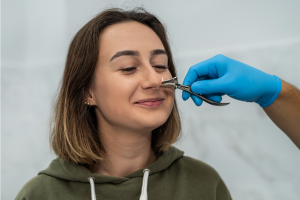Sinus infections, also called sinusitis, arise when inflammation and blockage afflict the air-filled cavities within your face. These cavities, known as sinuses, sit behind your forehead, cheekbones, and nose. Differentiating between viral and bacterial sinus infections is important for ensuring appropriate treatment. While both types can have similar symptoms, their underlying causes and management strategies diverge significantly. Understanding this distinction empowers you to make informed healthcare decisions and optimize your recovery.
Overview of Sinus Infections
Sinus infections can be caused by a multitude of factors, with the most prevalent culprits being viral and bacterial infections.
Viral Infections:
- Viruses, the cause of common colds and flu, are accountable for the lion’s share of sinusitis cases.
- They infiltrate the sinuses, triggering inflammation and mucus buildup, obstructing drainage pathways.
Bacterial Infections:
- Although less frequent, bacteria can also invade the sinuses, often piggybacking on a viral infection’s heels.
- They can either initiate a primary infection or capitalize on the vulnerability created by a viral invasion.
- Secondary bacterial infections can emerge when a viral infection compromises the sinuses’ defenses, paving the way for bacterial infiltration.
Clinical Presentation
While some symptoms might linger across both viral and bacterial variants, their duration, severity, and progression offer valuable clues.
Symptoms of Viral Sinus Infections:
Nasal Congestion: A persistent feeling of nasal blockage or stuffiness, hindering smooth airflow and breathing.
Runny Nose: A relentless flow of clear or slightly discolored mucus, potentially tinged with yellow or white hues. This discharge is the body’s attempt to flush out the viral invaders.
Sore Throat: An irritating scratchiness or rawness sensation in the throat, often accompanied by a nagging cough. This discomfort originates from the inflamed tissues lining the back of the throat, perpetually irritated by the postnasal drip—mucus cascading down from the sinuses.
Coughing: A reflex mechanism employed by the body to clear mucus buildup and expel the viral irritants from the airway. This repetitive hacking cough, though initially dry, might progress to producing phlegm as the infection advances.
Mild Facial Pain or Pressure: A dull, aching sensation around the nose, cheeks, or forehead, arising from the inflamed and congested sinuses. Think of it as your sinuses, once airy chambers, swelling like overinflated balloons, pressing against the surrounding bones and causing discomfort.
Duration: These symptoms typically last for 7-10 days, gradually retreating as your immune system conquers the viral army.
Symptoms of Bacterial Sinus Infections:
Although some symptoms may be similar to viral infections, bacterial infections often have more serious signs.
Prolonged Symptoms: If your cold-like symptoms, such as sniffles and congestion, don’t go away after 10 days, it could be a bacterial infection causing trouble in your sinuses for a longer time.
Symptoms Getting Worse: The face pain or pressure can get more intense, changing from a dull ache to a pulsating discomfort. It’s like feeling the pressure inside your sinuses building up, similar to a balloon about to burst.
Intense Facial Discomfort: Bacterial sinus infections can make your face really uncomfortable, especially around the affected sinuses. You might feel this discomfort in your forehead, cheeks, or around your eyes.
Thick, Discolored Nasal Discharge: If your runny nose starts producing thick, yellow, or green mucus, it’s a clear sign of a bacterial infection.
Fever: Unlike a regular cold, a bacterial infection might bring a fever, as your body tries to fight off the invaders by raising its temperature.
Duration: Bacterial infections are stubborn symptoms last more than 10 days, and any improvement you see at first might just be a break before more misery returns.
Physical Examination
During a physical examination, a doctor can gather more information by inspecting your nasal passages.
Physical Examination for Viral Sinus Infections:
Nasal Passages: Typically show mild swelling.
Nasal Discharge: Clear and not as abundant.
Other Signs: Generally, the overall physical findings are mild, and there may not be prominent signs of inflammation or pus.
A healthcare provider conducting a physical exam for a viral sinus infection would observe these relatively subtle signs, such as mild swelling in the nasal passages and a clear, less abundant nasal discharge.
Physical Examination for Bacterial Sinus Infections:
Nasal Passages: Severe congestion may be evident.
Nasal Discharge: Pronounced and may contain visible signs of inflammation or pus.
Other Signs: The physical findings are more severe compared to viral infections, with a higher likelihood of visible signs of inflammation or pus in the nasal passages.
During a physical exam for a bacterial sinus infection, healthcare providers may observe more pronounced signs, such as severe congestion in the nasal passages and a noticeable nasal discharge that could contain visible signs of inflammation or pus. These findings indicate a more intense and potentially bacterial nature of the infection.
Diagnostic Tools
While clinical presentation often suffices for diagnosing viral sinusitis, bacterial infections might require further investigation.
Viral Sinus Infections:
Viral sinus infections are commonly diagnosed based on symptom duration and presentation. Symptoms may include nasal congestion, headache, facial pain, and a runny nose. Testing for specific viruses, such as rhinovirus or influenza, may not be routinely conducted unless complications arise. Most viral sinus infections are self-limiting and resolve with symptomatic treatment.
Bacterial Sinus Infections:
In the case of bacterial sinus infections, a nasal swab or culture is often employed to identify the specific type of bacteria responsible for the infection. This allows healthcare providers to tailor antibiotic treatment to the particular pathogen involved. Imaging studies, such as computed tomography (CT) scans, might be utilized in severe or persistent cases. CT scans provide detailed images of the sinuses, aiding in the visualization of the extent of the infection and any potential complications, such as sinus abscesses.
Antibiotic Considerations
It’s important to note that overuse of antibiotics is a concern, and the decision to prescribe them should be based on a careful assessment of clinical symptoms and, when necessary, laboratory and imaging findings. Proper diagnosis and treatment contribute to effective management and the prevention of antibiotic resistance.
Viral Sinus Infections:
Antibiotics, designed to combat bacterial foes, are ineffective against viruses. Supportive care measures like hydration, rest, and over-the-counter pain relievers are the primary tools to alleviate symptoms and bolster the immune system.
Bacterial Sinus Infections:
Once the bacterial culprit is identified, targeted antibiotics may be used. The specific antibiotic chosen depends on the type of bacteria and its susceptibility to different medications.
Consultation with a Sinus Specialist
How to manage sinusitis:
Practice good hygiene: Frequent handwashing and avoiding close contact with people who are sick can minimize your exposure to germs.
- Stay hydrated: Drinking plenty of fluids thins mucus and aids in its clearance, easing congestion.
- Humidify the air: Using a humidifier or taking hot showers adds moisture to the air, soothing irritated sinuses.
- Elevate your head while sleeping: This promotes mucus drainage and can alleviate nighttime discomfort.
- Consider saline nasal sprays or neti pots: These tools can help clear mucus buildup and provide temporary relief.
Seeking expert guidance is crucial when navigating the complexities of sinusitis. A sinus specialist possesses advanced knowledge and tools to tackle intricate cases. They can meticulously assess your symptoms, medical history, and diagnostic results. Based on their comprehensive evaluation, they will chart the optimal treatment course, ensuring swift eradication of bacterial invaders.
Conclusion
Differentiating between the viral and bacterial invaders empowers you to navigate this common ailment with confidence. Armed with knowledge, you can make informed decisions about your health, ensuring swift and effective management of your nasal misery.
Remember:
- Viral infections typically exhibit a shorter duration of symptoms (7-10 days), gradual improvement, and mild physical findings. Supportive care measures are the key weapons in this battle.
- Bacterial infections often linger beyond 10 days, worsen after initial improvement, and display signs of inflammation and discolored discharge. Antibiotics become the necessary allies in this fight.
Seeking medical advice is paramount. Your doctor can assess your symptoms, conduct necessary tests, and determine the appropriate course of action.
By recognizing the differences between viral and bacterial sinusitis, taking proactive measures to prevent infection, and seeking prompt medical attention if needed, you can breathe freely once again.


 Practice good hygiene:
Practice good hygiene: